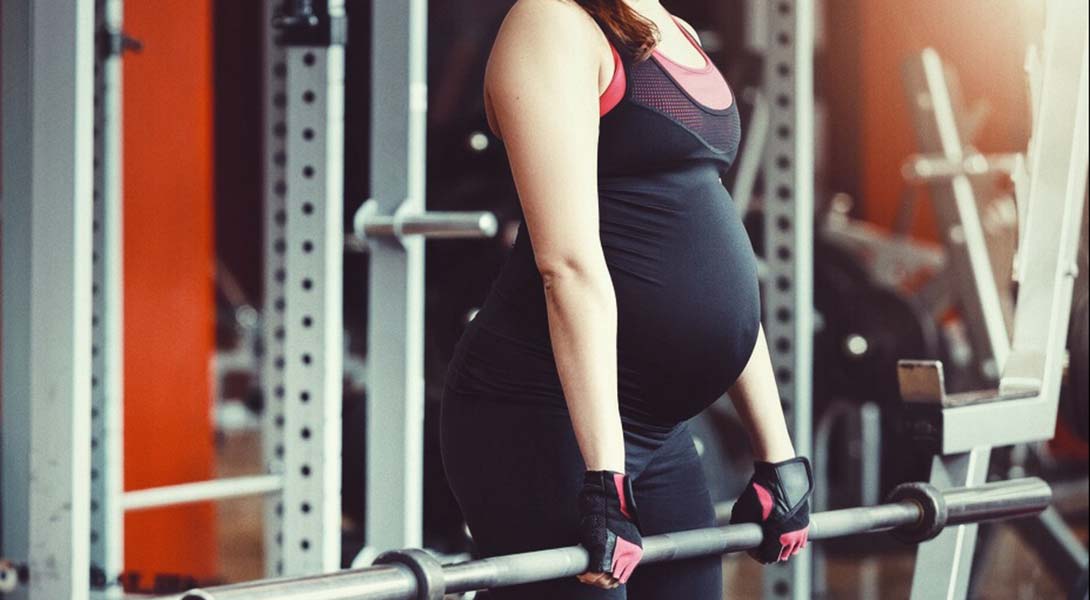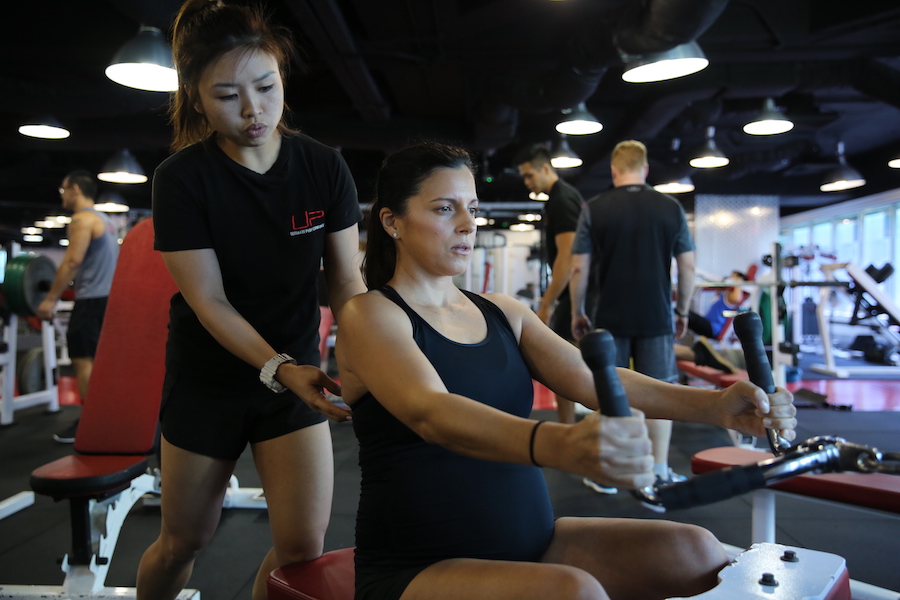Exercising to stay fit and healthy during pregnancy is more important than ever for both mother and baby.
Statistics show that 49.6% of pregnant women in England are overweight or obese. But pregnancy itself can be a big contributor to weight gain and its associated health problems – with an estimated 20% of women retaining over 5kg of additional weight one year after giving birth.
Exercise is not just effective for reducing excess weight gain in pregnancy and post-partum weight retention; for obese women, physical activity reduces the risk of pre-eclampsia, reduces pelvic and back pain, and helps to improve overall well-being.
But if you don’t know how to exercise safely during pregnancy or where to start, we share everything you need to know here – including the benefits of exercise and how to adapt your training in each of the three trimesters.
What are the benefits?
One of the contributors to unnecessary weight gain during pregnancy is that many women tend to lower their physical activity levels. While this is understandable given the many different changes occurring in your body during this time, there is plenty of evidence to suggest that physical exercise during pregnancy will help to maintain and improve fitness, which can also improve pregnancy outcomes.
The benefits of training through pregnancy include:
- Decreased risk of gestational diabetes.
- Reduced post-natal recovery time.
- Decreased risk and severity of back pain.
- Decreased risk of incontinence.
- Reduced risk of caesarean births.
- Reduced risk of low mood and depression.
- Improved physical fitness.

How should you train through pregnancy?
Tailoring your workout routine to your body and how you feel becomes even more crucial during pregnancy.
There are various points to consider and adjustments to make with your training during each stage of pregnancy throughout your nine-month journey.
In most cases, it is safe to resistance train through pregnancy, plus there are many benefits to staying active. However, you do need to be mindful of how you feel and make adjustments where necessary ensuring that:
- You have the all-clear from your doctor.
- You are free from contraindications.
- You follow the guidelines.
First trimester (weeks 1 to 12)
The first trimester is where you can increase strength and muscle mass relatively safely. The focus at this time should be the upper back, front of your core and posterior chain. Strengthening your trunk and upper body will help you build up strength to support your breasts as they grow, improve your ability to carry the growing weight and size of the uterus, and offset the forward shift in your centre of gravity.
Workouts that focus on pulling movements (think rows, pulldowns), lower body exercises (split squats, seated leg curl, glute bridges), pressing movements (overhead presses or bench presses), as well as functional training, like loaded carries.
The first trimester is also an opportunity to establish a good base of cardiovascular fitness. This can improve your training capacity and reduce your risk of gestational diabetes, pre-eclampsia, premature birth, incontinence, and back pain. Options may include some light cardio work or low-impact activity like walking.

Second trimester (weeks 13 to 27)
The second trimester is when many of the more unpleasant symptoms of pregnancy begin to subside, and you may start to feel more energised. As a result, the second trimester is a great time for training.
One of the benefits of strength training during the second trimester is that it can help reduce lower back and pelvic pain. You may need to adjust some exercises, such as using a shorter stride length during split squats or lunges, avoiding standing on one leg, or avoiding very wide squats. Day-to-day hacks like using a pillow between your knees when sleeping or moving around in bed, using a support belt and avoiding sitting down in a slouched position can all help improve symptoms of pelvic pain.
When it comes to training, while you may have been able to continue with relatively the same weights as previously in your first trimester, you may need to back off slightly as you move into the second. Your core and pelvic floor muscles are now under increased pressure, so it’s likely you won’t be able to stabilise yourself as effectively or be able to push as hard.
You may also need to tweak your exercise selection during this time. While many barbell exercises remain safe during the second trimester, avoid movements that involve moving the barbell explosively past the midsection, as often found in Olympic lifts. If you feel supported in your core and pelvic floor while exercising, you should be okay to continue with a variety of barbell exercises. However, reduce the intensity or switch things up if you feel a lot of downward pressure on your pelvic floor, sensations of bulging through the pelvic floor or a bulging or doming feeling along the linea alba (the connective tissue that connects both sides of the rectus abdominis). If you do feel excessive downward pressure or doming, you may need to adapt your training by:
- Decreasing the load.
- Changing the reps/ sets.
- Switching up your breathing.
- Decreasing the range of motion.
- Increasing your degree of stability, e.g. if you’re doing a split squat, move to a rack where you can hold onto one side for support.
- Change the position of the load, e.g. a dumbbell by your side or use a trap bar rather than a traditional straight bar for deadlifts.
- Avoid creating excessive intra-abdominal pressure.
- Try different techniques, e.g. switch a barbell hip thrust for bodyweight hip thrusts or move to a single-leg version with a dumbbell.
- Stop if you feel like you need a rest or feel very out of breath.
Women are often advised not to lie on their backs for extended periods during the second trimester, as the baby’s weight can impinge the vena cava, the main vein that carries blood back to the heart from the lower body.
However, exercising for short periods, e.g. a 30-60 second dumbbell bench press, is likely to be safer than lying on your back for extended periods. Keep an eye on how you feel and if you don’t feel comfortable, try raising the angle of the bench or propping yourself up with a mat or pad.

Third trimester (weeks 28 to 40)
The third trimester is likely when you’ll see your body change the most, especially in your midsection. As a result, you’re likely to be a lot less mobile, and even simple day-to-day tasks will feel like they require a lot more effort than usual. You may also find that your sleep quality and quantity has declined, so you may not feel quite as energised for training. It’s completely okay not to be smashing it in the gym and give yourself a pat on the back for whatever activity you can continue to perform during this time.
In reaching the final stages of pregnancy, the main goal should be to support you rather than provide a competing demand on the body. As a result, base your training on how you feel.
If you find you can continue with your previous routine, great. If you feel like you need to rest, that’s also okay. You may choose to stop training altogether towards the end of your pregnancy. You may want to continue with some movement, like gentle stretches or mobility drills, such as:
- Hip circles.
- Hip flexor stretches.
- Cat-cow stretches.
- Thread the needle.
- A wide child’s pose.
- Swiss ball pelvic tilts and circles.
- Tailor stretches.
These exercises can help alleviate stiffness and pain and help the baby move into a better position for birth. You may also want to incorporate some birth preparation exercises during the final trimester, such as guided breathing.
Make sure to rest as much as possible between sets and rest through the day. At the very least, try to take as many breaks as possible and avoid standing for long periods.
In the third trimester, you may need to adjust/ tweak your training by:
- Adjusting or removing supine exercises if they don’t feel comfortable. even elevating the bench by 15-30 degrees can help alleviate discomfort.
- Avoiding barbell exercises that require you to move the bar across your stomach.
- Avoiding holding your breath during exercise.
- Scale the weight or reps back if it feels like it’s too much.
- Switching crunches for loaded carry variations or palov press, wood chops, etc.
- Avoiding exercises that cause your stomach to bulge or dome across the linea alba.
- Avoiding exercises that cause a lot of downward pressure on the pelvic floor. This may feel like heaviness in the perineum or increased need or urgency to urinate. If you experience symptoms of pelvic floor dysfunction, refer to a pelvic health physiotherapist.

Read how Lola’s trainer helped her train safely to overcome her diastasis recti and lose 15kg.
What about nutritional choices?
Nutrition during pregnancy will help shape your baby’s health and food preferences, which can affect their long-term health. Despite what many think, you don’t need to eat for two. In fact, your energy needs may only increase by a few hundred extra calories.
Your diet should mainly focus on foods rich in micronutrients such as folate, omega-3 fatty acids and vitamin D to provide your baby with the best start in life. Supplementation can also help plug any gaps in your diet, but it is best to consult with your doctor before taking any.
Managing stress and sleep are also vitally important for minimising cortisol levels (your stress hormone) in the foetus.
The take-home
Reaching and maintaining a healthy body composition before and during pregnancy plays a crucial role in health outcomes for you and your baby. If you have the all-clear from your doctor or midwife, it is safe to train through pregnancy. However, your focus may change, and you may need to adapt exercises based on how you feel and where you are in your pregnancy journey.
If you are concerned about your training, diet or lifestyle through pregnancy, speak to your doctor or midwives, who will be able to best advise for your unique circumstances.
Want 9 more reasons why you should be exercising while pregnant? Click here to read.



